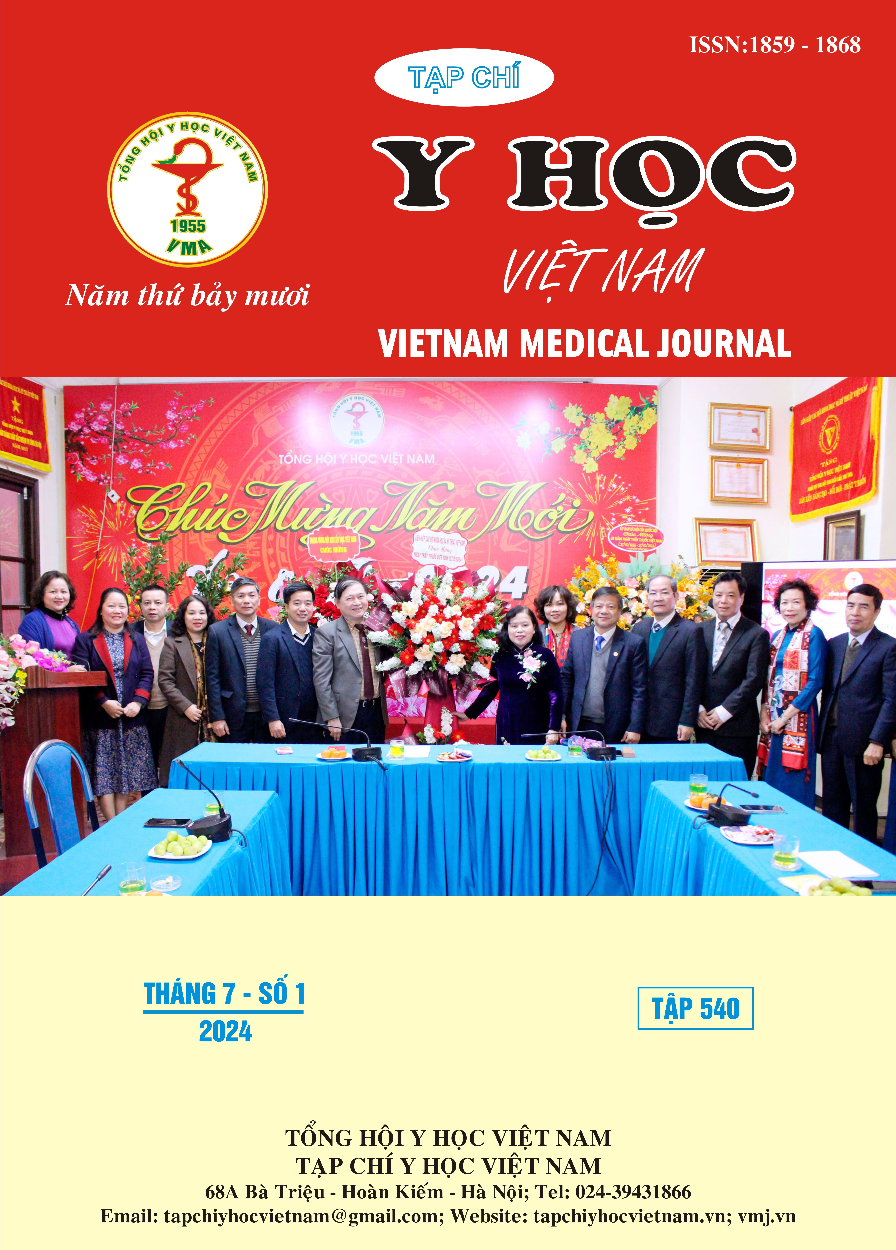NỒNG ĐỘ D-DIMER Ở BỆNH NHÂN COVID-19 TRUNG BÌNH VÀ NẶNG ĐIỀU TRỊ TẠI BỆNH VIỆN BỆNH NHIỆT ĐỚI TRUNG ƯƠNG GIAI ĐOẠN 2021-2023
Nội dung chính của bài viết
Tóm tắt
Nghiên cứu hồi cứu trên 214 bệnh nhân COVID-19 trung bình và nặng trên 18 tuổi điều trị tại bệnh viện bệnh nhiệt đới Trung ương giai đoạn 2021-2023 nhằm khảo sát sự thay đổi của D-dimer lúc nhập viện và trong quá trình điều trị. Kết quả: Lúc nhập viện, D-dimer tăng cao hơn giá trị bình thường ở tất cả các bệnh nhân. Ở nhóm COVID-19 trung bình, không có sự khác biệt về nồng độ D-dimer ở các ngày 3,7,14 so với ngày nhập viện. Trái lại ở nhóm nặng, D-dimer tăng cao dần từ ngày 7 và tăng cao có ý nghĩa thống kê ở ngày 14 so với ngày nhập viện: 1637 ng/mL (IQR 849–3968,8) so với 1170,5 ng/mL (IQR 605–2573), p<0,001. Tại ngày 7 và 14, D-dimer ở nhóm nặng cao hơn có ý nghĩa thống kê so với nhóm trung bình: 1549 ng/mL (IQR 983,5- 2609,5) so với 1138 ng/mL (IQR 609,3 – 1858), p<0,01 và 1637 ng/ml (IQR 849-3968,8) so với 1020 ng/mL (IQR 521-1830), p<0,001; lần lượt. Tỷ lệ bệnh nhân giảm tiểu cầu đồng thời với D-dimer trên 2500 ng/mL lúc nhập viện ở nhóm tiến triển lâm sàng nặng lên cao hơn so với nhóm không tiến triển nặng (16,7% so với 6,8%, p<0,05). Kết luận: Mức tăng của D-dimer có liên quan với diễn biến nặng của COVID-19, đặc biệt là ở ngày thứ 7 và 14 sau nhập viện.
Chi tiết bài viết
Từ khóa
: D-dimer, COVID-19 trung bình, COVID-19 nặng, tiến triển nặng.
Tài liệu tham khảo
2. Bộ Y tế. Bản tin Covid-19. Cổng thông tin của Bộ Y tế về đại dịch COVID-19. Accessed November 19, 2023. https://covid19.gov.vn/ban-tin-covid-19.htm
3. Iba T, Levy JH, Connors JM, Warkentin TE, Thachil J, Levi M (2020). The unique characteristics of COVID-19 coagulopathy. Critical Care. 2020; 24(1):360. doi:10.1186/s13054-020-03077-0.
4. Bộ Y tế. Hướng dẫn chẩn đoán và điều trị COVID19. Quyết định 2671/QĐ-BYT ngày 26/6/2023.
5. Varikasuvu S, Varshney S, Dutt N, Munikumar M, Asfahan S, Kulkari P, Gupta P (2021). D-dimer, disease severity, and deaths (3D-study) in subjects with COVID-19: a systematic review and meta-analysis of 100 studies. Sci Rep 2021; 11:21888. doi: 10. 1038/s41598-021-01462-5.
6. Bikdeli B, Madhavan MV, Jimenez D, et al (2020). COVID-19 and Thrombotic or Thromboembolic Disease: Implications for Prevention, Antithrombotic Therapy, and Follow-Up. Journal of the American College of Cardiology. 2020; 75(23): 2950-2973. doi: 10.1016/j.jacc.2020.04.031
7. Thachil J. Hypoxia—An overlooked trigger for thrombosis in COVID-19 and other critically ill patients. J. Thromb. Haemost. 2020;18:3109–3110. doi: 10.1111/jth.15029.
8. Loo J., Spittle D.A., Newnham M. (2020). COVID-19, immunothrombosis and venous thromboembolism: Biological mechanisms. Thorax. 2021; 76: 412–420. doi: 10.1136/ thoraxjnl-2020-216243.
9. Bao C, Tao X, Cui W, et al (2020). SARS-CoV-2 induced thrombocytopenia as an important biomarker significantly correlated with abnormal coagulation function, increased intravascular blood clot risk and mortality in COVID-19 patients. Exp Hematol Oncol. 2020; 9:16. doi:10.1186/ s40164-020-00172-4
10. Zhu Y, Zhang J, Li Y, Liu F, Zhou Q, Peng Z (2021). Association between thrombocytopenia and 180-day prognosis of COVID-19 patients in intensive care units: A two-center observational study. PLoS One; 2021; 16(3):e0248671. doi:10.1371/journal.pone.0248671


